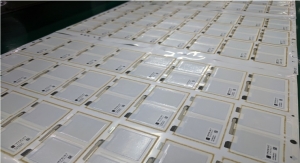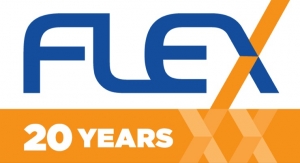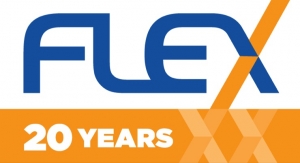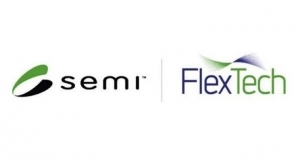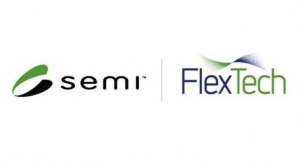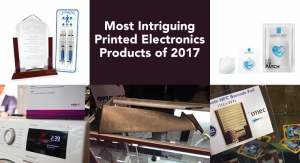David Savastano, Editor01.31.18
The ability to communicate with consumers is not necessarily through visual keys alone. Audio capabilities are also an excellent approach. However, the development of cost-effective, mass producible, truly thin speakers has yet to take off.
PARC, a Xerox Company, may have the key to unlocking this technology. In conjunction with FlexTech, a SEMI Strategic Association Partner, PARC researchers are working on a one-year project developing paper-like smart tags printed flexible audio speakers that could be used for smart tags, wearables and much more.
Under the project, PARC will use inkjet printing for the prototypes, which would be produced on plastic sheets by printing the active materials and silver ink conductive traces.. PARC will also create a process for bonding chips, as well as printing active and passive components and interconnects necessary to drive the speakers.
Dr. Bob Street, senior research fellow and project technical lead at PARC, said that when FlexTech put out a call for projects, printed audio speakers came immediately to mind.
“This is something I have been interested in for quite a while, and it’s a good opportunity to get back into printed actuators,” Dr. Street said. “FlexTech has a number of members who are interested in this technology. It seems like a good fit for our printed electronics technology.” He added that numerous markets would be ideal for this speaker technology, including smart tags, food safety, wearables and tracking packages.
“We worked on a project for piezo actuators for sound years ago,” added Dr. Janos Veres, program manager, Novel and Printed Electronics, Electronic Materials and Devices Laboratory at PARC.
Dr. Veres sees numerous potential uses for this technology.
“It could be useful for wearables and sensors, and fits the IoT environment,” Dr. Veres reported. “We see this progressing in many interesting ways, thousands and even millions of different opportunities. Customization is very interesting, for example in smart packaging, combining the graphics look and smart interactive functions.”
Dr. Street said that printing the speaker would work well with numerous processes.
“We are very open to different technologies, including inkjet, screen and gravure,” said Street. “Inkjet can be a low-cost technology, and it provides the opportunity to customize the device. Analog works really well for long runs, and digital is ideal for short runs. You can create thousands of devices with different designs.”
There are technical challenges is developing flexible printed speakers.
“There have been some developments in terms of speakers, but they are not functional yet,” Dr. Street noted. “A regular speaker is designed to be three-dimensional. The real challenge for us is to get it really thin. It is a big open space, and we are trying different possibilities out.”
Ultimately, the benefit of reaching the consumer will drive the development of printed audio speakers.
“Consumer product companies want devices that are connected to the real world,” said Dr. Veres. “Smart packaging is the first wave, then comes customizable wearables whose design would depend on the person in terms of health monitoring and fashion. The third wave is structural electronics, which will benefit significantly from printing. For example, automotive and aerospace companies can reduce the complexity and weight of their parts.”
“Printed speakers are an exciting technology,” Dr. Street continued. “It enables everyday objects to communicate with the user. One way to do that is visually, with displays, and another is audio, which can provide the user with a different information channel.”
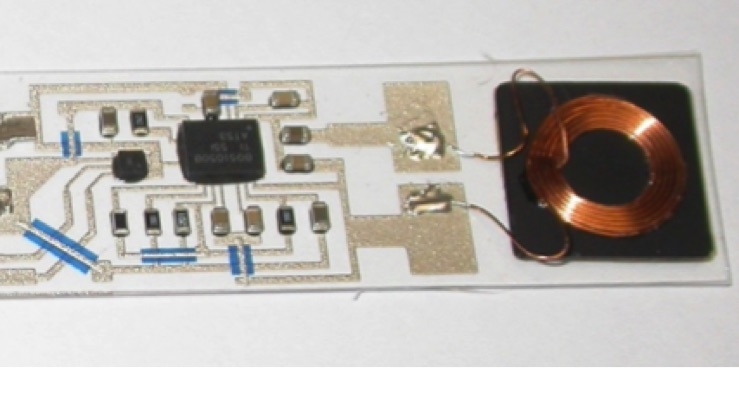
A printed flexible hybrid circuit recently fabricated at PARC, comprising an electro-chemical sensor, Bluetooth communication and inductive charging. (Photo courtesy of PARC).
PARC, a Xerox Company, may have the key to unlocking this technology. In conjunction with FlexTech, a SEMI Strategic Association Partner, PARC researchers are working on a one-year project developing paper-like smart tags printed flexible audio speakers that could be used for smart tags, wearables and much more.
Under the project, PARC will use inkjet printing for the prototypes, which would be produced on plastic sheets by printing the active materials and silver ink conductive traces.. PARC will also create a process for bonding chips, as well as printing active and passive components and interconnects necessary to drive the speakers.
Dr. Bob Street, senior research fellow and project technical lead at PARC, said that when FlexTech put out a call for projects, printed audio speakers came immediately to mind.
“This is something I have been interested in for quite a while, and it’s a good opportunity to get back into printed actuators,” Dr. Street said. “FlexTech has a number of members who are interested in this technology. It seems like a good fit for our printed electronics technology.” He added that numerous markets would be ideal for this speaker technology, including smart tags, food safety, wearables and tracking packages.
“We worked on a project for piezo actuators for sound years ago,” added Dr. Janos Veres, program manager, Novel and Printed Electronics, Electronic Materials and Devices Laboratory at PARC.
Dr. Veres sees numerous potential uses for this technology.
“It could be useful for wearables and sensors, and fits the IoT environment,” Dr. Veres reported. “We see this progressing in many interesting ways, thousands and even millions of different opportunities. Customization is very interesting, for example in smart packaging, combining the graphics look and smart interactive functions.”
Dr. Street said that printing the speaker would work well with numerous processes.
“We are very open to different technologies, including inkjet, screen and gravure,” said Street. “Inkjet can be a low-cost technology, and it provides the opportunity to customize the device. Analog works really well for long runs, and digital is ideal for short runs. You can create thousands of devices with different designs.”
There are technical challenges is developing flexible printed speakers.
“There have been some developments in terms of speakers, but they are not functional yet,” Dr. Street noted. “A regular speaker is designed to be three-dimensional. The real challenge for us is to get it really thin. It is a big open space, and we are trying different possibilities out.”
Ultimately, the benefit of reaching the consumer will drive the development of printed audio speakers.
“Consumer product companies want devices that are connected to the real world,” said Dr. Veres. “Smart packaging is the first wave, then comes customizable wearables whose design would depend on the person in terms of health monitoring and fashion. The third wave is structural electronics, which will benefit significantly from printing. For example, automotive and aerospace companies can reduce the complexity and weight of their parts.”
“Printed speakers are an exciting technology,” Dr. Street continued. “It enables everyday objects to communicate with the user. One way to do that is visually, with displays, and another is audio, which can provide the user with a different information channel.”

A printed flexible hybrid circuit recently fabricated at PARC, comprising an electro-chemical sensor, Bluetooth communication and inductive charging. (Photo courtesy of PARC).



